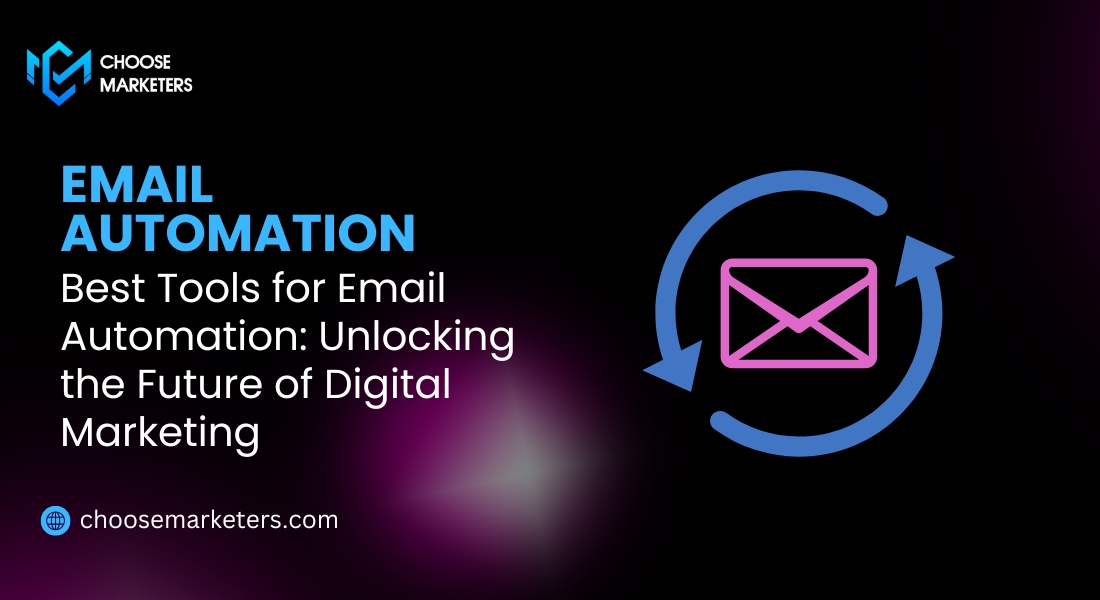

Best Tools for Email Automation: Unlocking the Future of Digital Marketing
In the rapidly evolving digital marketing landscape, businesses must constantly look for ways to stay ahead. Email automation is a key technology that enables marketers to connect with their audiences efficiently and at scale. With the right tools, businesses can engage customers at every stage of the buyer’s journey by sending personalized, timely emails based on customer behaviors and actions. This blog will explore the best tools for email automation, key features to look for, and the latest advancements in AI-driven automation. We will also address the gaps in the current content landscape, filling in what’s missing from existing resources.

Email Automation and Its Importance in Modern Marketing
Email automation refers to sending emails automatically based on user triggers or predefined timelines. This technology helps businesses save time, nurture leads, and build strong relationships with their audience by sending the right message at the right time.
In today’s marketing environment, email automation is essential for businesses of all sizes. Whether you’re welcoming new subscribers, reminding customers of abandoned carts, or following up on purchases, automation ensures that your emails are timely and relevant. The personalized experience offered by email automation can significantly boost engagement, increase conversions, and improve overall customer retention.
Core Features of Effective Email Automation Software
When selecting an email automation tool, businesses need to look for the following essential features:
Automated Workflows: These are pre-set sequences of emails that are triggered based on specific user actions, such as signing up for a newsletter or making a purchase.
Segmentation: This feature allows businesses to segment their audience based on demographic data, behaviors, or preferences, enabling more personalized email campaigns.
Personalization: Effective email automation platforms allow for deep personalization, making each recipient feel like the email is tailor-made for them.
Multi-channel Integration: Some tools enable email automation to work alongside other communication channels, such as SMS and push notifications.
Analytics and Reporting: Detailed reporting capabilities are essential for tracking the success of your email campaigns and understanding customer engagement.
Maximizing Engagement Through Advanced Personalization
One of the biggest gaps in existing email automation content is the lack of focus on advanced personalization. While most tools offer basic personalization, such as including the recipient’s name, AI-driven personalization takes it to the next level.
Advanced personalization allows businesses to send highly targeted emails based on individual customer behaviors, past purchases, browsing history, and even predicted future actions. For instance, AI can predict what products a customer might be interested in based on their purchase history, enabling businesses to send tailored recommendations in real time.
This level of personalization goes beyond what most platforms currently offer and is a key area where businesses can gain a competitive edge.
Top Email Automation Tools for 2024
Several tools stand out in the email automation space for their unique features and capabilities:
1. Mailchimp
Known for its user-friendly interface, Mailchimp is ideal for small to medium-sized businesses. It offers a range of templates and automation features like segmentation, A/B testing, and cart abandonment emails. However, Mailchimp lacks advanced AI-driven personalization features.
2. Omnisend
This platform is particularly strong in e-commerce automation, offering email, SMS, and push notification integration. Its pre-built workflows are useful, but its customization options can be limited.
3. ActiveCampaign
One of the best tools for workflow customization, ActiveCampaign excels in allowing businesses to create highly tailored automation sequences. It also integrates seamlessly with many CRM systems. However, it can be complex for beginners.
4. Neil Patel’s Recommendations (Drip, Mailshake)
These tools offer excellent automation features for small businesses and startups but lack the depth of features needed by larger enterprises, particularly when it comes to multi-channel integration and advanced segmentation.
Measuring the ROI of Email Automation Campaigns
Understanding how to measure the ROI of email automation is crucial for businesses to justify their investment in the technology. Key performance indicators (KPIs) include:
Open Rate: This metric shows how many recipients open your emails and is a good indicator of the effectiveness of your subject lines.
Click-Through Rate (CTR): This tracks how many recipients clicked on links within the email.
Conversion Rate: Measures how many email recipients completed a desired action, such as making a purchase.
Customer Lifetime Value (CLV): Measures the long-term value of customers acquired through email automation.
Time and Cost Savings: Automation reduces the time and effort needed for manual email campaigns, which translates into cost savings.
Avoiding Common Pitfalls in Email Automation
Over-automation is one of the most common mistakes businesses make. While email automation can save time, sending too many automated emails can overwhelm your audience and lead to high unsubscribe rates. Other pitfalls include:
Generic Content: Automation shouldn’t mean impersonal emails. It’s crucial to make sure each email is highly relevant to the recipient.
Over-Segmentation: While segmentation is useful, going too granular can dilute the impact of your messages.
Lack of Follow-Up: While automated emails are useful, businesses should not rely solely on them. A human touch is sometimes necessary.
Integrating Email Automation with Multi-Channel Marketing
A significant gap in existing content is the lack of focus on multi-channel marketing integration. Many businesses rely solely on email automation when they should be incorporating other channels, such as:
SMS: Follow up on emails with SMS reminders for a more immediate touchpoint.
Push Notifications: Use push notifications for real-time engagement with your audience.
Social Media: Integrating email with social media campaigns ensures consistent messaging across platforms.
Customizing Automation Workflows to Suit Business Needs
Pre-built workflows are useful, but customizing them to fit your specific business needs can greatly improve their effectiveness. ActiveCampaign, for example, offers highly customizable workflows, allowing businesses to tailor email sequences based on customer journeys, behaviors, and interactions. Customization is particularly important for businesses with unique customer journeys, such as B2B companies or industries with long sales cycles.
The Role of AI in the Future of Email Automation
As the digital marketing landscape evolves, Artificial Intelligence (AI) is becoming a game-changer in email automation. By leveraging AI, businesses can significantly enhance their email campaigns through advanced personalization, predictive analytics, and dynamic content generation. Let’s explore how AI is shaping the future of email automation and the key benefits it brings to businesses.
1. Hyper-Personalization: Beyond Basic Details
Traditional email personalization, like adding a recipient’s name, is no longer enough. AI allows businesses to create hyper-personalized emails by analyzing customer data such as browsing habits, past purchases, and even real-time behavior. This enables businesses to send highly relevant product recommendations, offers, and content tailored to each individual, leading to higher engagement and conversions.
2. Predictive Analytics: Anticipating Customer Needs
AI-driven predictive analytics empowers businesses to anticipate customer actions before they happen. By analyzing historical data, AI can predict when a customer is likely to make a purchase or churn. Businesses can then automatically send targeted emails, such as special offers, at precisely the right moment, boosting the chances of conversion and customer retention.
3. Dynamic Content Generation
AI tools can generate dynamic content that adapts in real-time based on customer behavior or external factors, such as product availability or pricing changes. For example, an email can automatically update product recommendations or display tailored offers, ensuring recipients receive the most relevant information, improving the user experience.
4. Optimized Send Times and Frequency
Determining the best time to send emails is no longer guesswork. AI can analyze recipient behaviors and determine the optimal time and frequency to send emails for each individual. This results in better open rates and less chance of overwhelming customers with excessive emails.
5. Automated A/B Testing and Real-Time Optimization
AI automates A/B testing by running real-time tests across different email segments. Based on performance data, AI can quickly determine which email variations—such as subject lines or call-to-actions—work best and adjust future campaigns accordingly. This real-time optimization helps businesses continuously improve their email strategies.
The Future of AI in Email Automation
AI will continue to transform email automation, enabling businesses to create even more personalized, timely, and effective marketing strategies. Future advancements may include voice and video integration, sentiment analysis, and full customer journey automation, where AI manages the entire communication process from awareness to post-purchase.
Choosing the Right Email Automation Service
Selecting the right email automation tool depends on several factors, including:
Business Size: Small businesses may prefer a simpler tool like Mailchimp, while larger enterprises may require the advanced features offered by ActiveCampaign.
Industry: E-commerce businesses can benefit from Omnisend’s multi-channel capabilities, while service-based businesses might prefer Drip or Mailshake for lead nurturing.
Budget: Tools like Mailchimp offer free tiers, while ActiveCampaign and Omnisend provide more advanced features at higher costs.
Key Performance Indicators for Email Automation Success
To measure the success of your email automation campaigns, track the following KPIs:
Open Rate: Shows the percentage of recipients who open your email.
Click-Through Rate (CTR): Indicates how many recipients clicked on a link within the email.
Conversion Rate: Tracks how many recipients took a desired action, such as making a purchase or signing up for a service.
Unsubscribe Rate: Monitors how many recipients opted out of your email list after receiving an email.
Engagement Metrics: Look at overall engagement, such as how long recipients are interacting with your emails
Hiring Email Marketing Experts for Automation
To fully leverage email automation, businesses need skilled professionals who understand both the technical and creative aspects of email marketing. When hiring for email automation roles, look for candidates with the following skills:
Experience with Automation Tools: Candidates should be proficient in platforms like Mailchimp, ActiveCampaign, or Omnisend.
Strong Analytical Skills: Email marketers should know how to analyze KPIs and optimize campaigns accordingly.
Creativity: While technical skills are important, creativity in crafting engaging email content is essential.
Understanding of Multi-channel Marketing: Ideal candidates should know how to integrate email with other channels like SMS and social media.
Real-Time Analytics and Continuous Optimization Strategies
One of the most overlooked aspects of email automation is the importance of real-time analytics. Monitoring campaign performance in real-time allows businesses to adjust their strategies quickly and optimize email sequences for better results.
Using advanced analytics tools, businesses can A/B test email subject lines, content, and CTAs to determine what resonates best with their audience. Real-time data helps marketers understand customer behavior more accurately and refine their approach accordingly.
Overcoming Challenges in Setting Up Email Automation Workflows
Setting up email automation can be challenging, especially for businesses new to the concept. Common challenges include:
Complexity of Tools: Some platforms have steep learning curves, making it difficult for beginners to get started.
Data Integration: Integrating customer data from various sources into your email platform can be challenging but is necessary for effective personalization.
Workflow Customization: While pre-built workflows are available, customizing them to fit your specific business needs can be time-consuming.
To overcome these challenges, businesses should invest in training, choose tools that match their level of expertise, and focus on optimizing workflows over time.
Conclusion: Choosing the Right Email Automation Service
Choosing the right email automation service depends on your business size, goals, and budget. Whether you’re looking for basic workflows or advanced AI-driven personalization, the right tool can make all the difference in your marketing efforts.
By focusing on personalization, integrating multi-channel marketing, and using real-time analytics to optimize performance, businesses can create impactful, engaging email campaigns that resonate with their audience.

